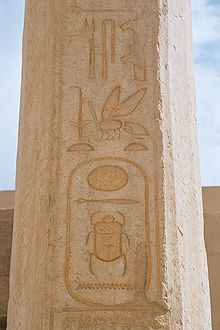Ancient Egyptian royal titulary
The full titulary, consisting of five names, did not come into standard usage until the Middle Kingdom but remained in use as late as the Roman Empire.
In order that the pharaoh, who held divine office, could be linked to the people and the gods, special epithets were created for them at their accession to the throne.
[2] This name placed the king under the protection of two female deities, Nekhbet and Wadjet[4] and began sometime towards the end of the First Dynasty as a reference to "The one who belongs to Upper and Lower Egypt", along with mention of the Two Ladies.
[6] At least one Egyptian ruler, the Second Dynasty pharaoh Seth-Peribsen, used an image of the god Set instead of Horus, perhaps signifying an internal religious division within the country.
This particular name was not typically framed by a cartouche or serekh, but always begins with the hieroglyphs of a vulture and cobra resting upon two baskets, the dual noun "nebty".
(The sedge and the bee symbolised Upper and Lower Egypt, respectively,[7][8] although recent research has thrown this interpretation into doubt.
It was first introduced to the set of royal titles in the Fourth Dynasty and emphasizes the king's role as a representative of the solar god Ra.


